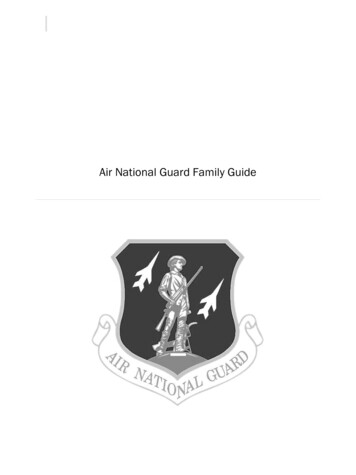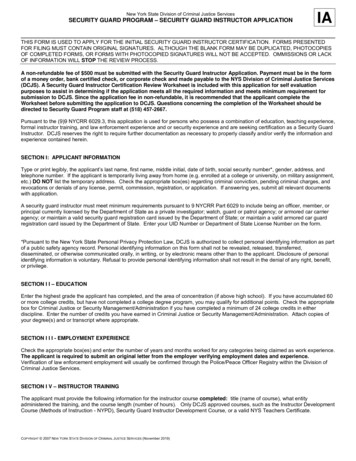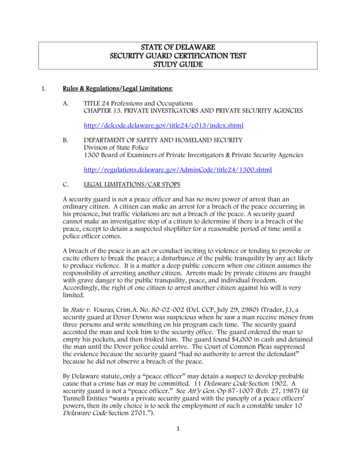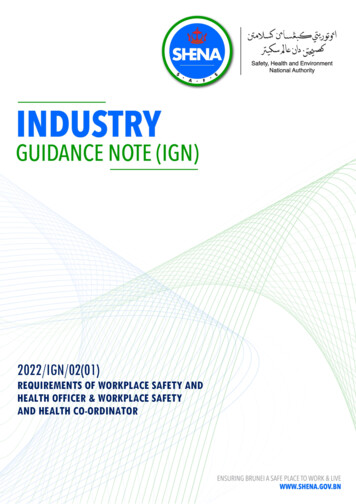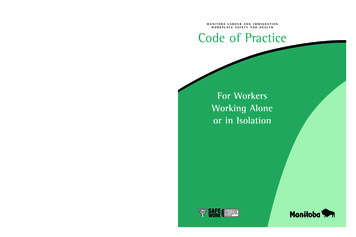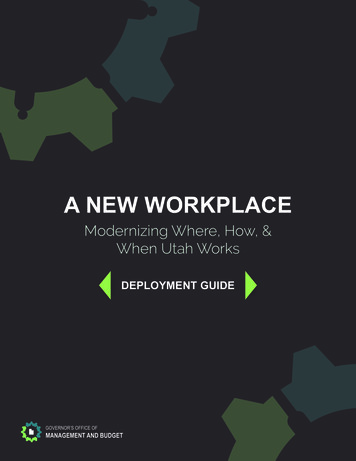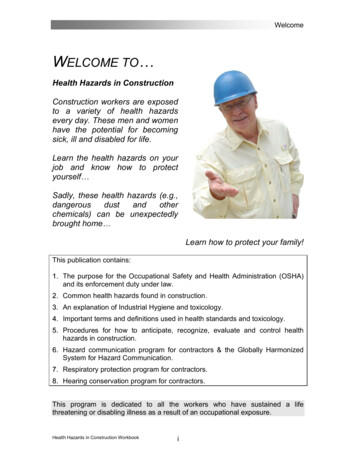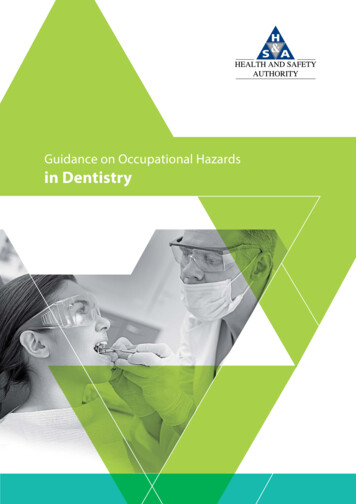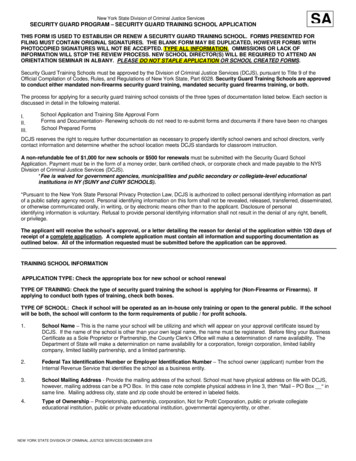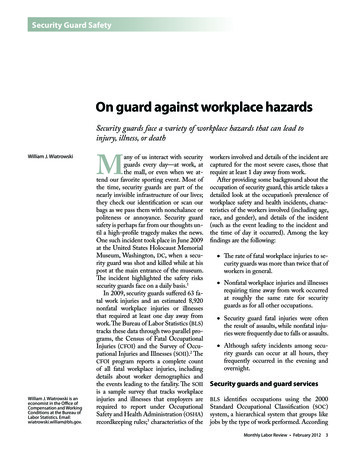
Transcription
Security Guard SafetyOn guard against workplace hazardsSecurity guards face a variety of workplace hazards that can lead toinjury, illness, or deathWilliam J. WiatrowskiWilliam J. Wiatrowski is aneconomist in the Office ofCompensation and WorkingConditions at the Bureau ofLabor Statistics. Email:wiatrowski.william@bls.gov.Many of us interact with securityguards every day—at work, atthe mall, or even when we attend our favorite sporting event. Most ofthe time, security guards are part of thenearly invisible infrastructure of our lives;they check our identification or scan ourbags as we pass them with nonchalance orpoliteness or annoyance. Security guardsafety is perhaps far from our thoughts until a high-profile tragedy makes the news.One such incident took place in June 2009at the United States Holocaust MemorialMuseum, Washington, DC, when a security guard was shot and killed while at hispost at the main entrance of the museum.The incident highlighted the safety riskssecurity guards face on a daily basis.1In 2009, security guards suffered 63 fatal work injuries and an estimated 8,920nonfatal workplace injuries or illnessesthat required at least one day away fromwork. The Bureau of Labor Statistics (BLS)tracks these data through two parallel programs, the Census of Fatal OccupationalInjuries (CFOI) and the Survey of Occupational Injuries and Illnesses (SOII).2 TheCFOI program reports a complete countof all fatal workplace injuries, includingdetails about worker demographics andthe events leading to the fatality. The SOIIis a sample survey that tracks workplaceinjuries and illnesses that employers arerequired to report under OccupationalSafety and Health Administration (OSHA)recordkeeping rules;3 characteristics of theworkers involved and details of the incident arecaptured for the most severe cases, those thatrequire at least 1 day away from work.After providing some background about theoccupation of security guard, this article takes adetailed look at the occupation’s prevalence ofworkplace safety and health incidents, characteristics of the workers involved (including age,race, and gender), and details of the incident(such as the event leading to the incident andthe time of day it occurred). Among the keyfindings are the following: The rate of fatal workplace injuries to security guards was more than twice that ofworkers in general. Nonfatal workplace injuries and illnessesrequiring time away from work occurredat roughly the same rate for securityguards as for all other occupations. Security guard fatal injuries were oftenthe result of assaults, while nonfatal injuries were frequently due to falls or assaults. Although safety incidents among security guards can occur at all hours, theyfrequently occurred in the evening andovernight.Security guards and guard servicesidentifies occupations using the 2000Standard Occupational Classification (SOC)system, a hierarchical system that groups likejobs by the type of work performed. AccordingBLSMonthly Labor Review February 2012 3
Security Guards Workplace Hazardsto the SOC occupational definition, the work of a security guard includes guarding, patrolling, or monitoringpremises to prevent theft, violence, or infractions of rules.The BLS 2010–2011 Occupational Outlook Handbook expands upon this definition as follows: “Security guards,also called security officers, patrol and inspect propertyto protect against fire, theft, vandalism, terrorism, andillegal activity.” In addition, security guards “protect theiremployer’s property, enforce laws on the property, [and]deter criminal activity.”4 Security guards work at a widevariety of worksites, including schools, warehouses, residential facilities, and retail establishments.The BLS Occupational Employment Statistics (OES)program estimates that there were approximately 1 million security guards in 2009.5 Slightly more than half ofthese guards were employed in the investigation, guard,and armored car services industry, which supplies security guards to a wide variety of other businesses. Often,the security guard that greets you each morning as youenter your employer’s facility is not employed by youremployer but by one of these contract organizations.The remaining guards were employed by a wide varietyof private and government organizations.While many workplace incidents among peoplewhose occupation is security guard involved those whowere working for guard services, some of the guardsinvolved were employed by other industries, includingretail trade, eating and drinking places, schools, andhospitals.Table 1.Employment, fatal work injuries, and nonfatal occupational injuries and illnesses in the guard services industryand security guard occupation, 2009Industry or occupationEmploymentInvestigation, guard, and armored carservices industry (NAICS code 561610)Security guard occupation(SOC code 33–9032)Nonfatal injuriesand illnessesNonfatal injuries andillnesses involvingat least 1 day awayfrom 0031Nearly 87 percent (593,370) of these workers were security guards;the remaining 13 percent worked in other occupations.2Employment data consistent with that shown for the investigation,guard, and armored car services industry are not available; other sourcesof employment data indicate that the security guards and patrol servicesindustry composes nearly 90 percent of the broader industry.3Nearly 58 percent (593,370) of these workers were employedby the investigation, guard, and armored car services industry; theremaining 42 percent were employed by other industries.Monthly Labor Review February 2012Fatal work injuries684,4201Security guards and patrol servicesindustry (NAICS code 561612)4In contrast, the guard services industry recorded 29 fatalwork injuries and an estimated 4,200 nonfatal workplace injuries and illnesses that required at least 1 day away from workin 2009. (The total number of nonfatal injuries and illnessesamong people employed by the guard services industry was10,500.6) Table 1 provides a matrix showing the relationshipbetween the security guard occupation and the guard servicesindustry. While many workplace injuries, illnesses, and fatalities in the guard services industry happen to guards, such incidents also happen to guards working in other industries.The fact that half of the workers in the security guard occupation were employed by contracting agencies, which sendworkers to any number of job locations in varying industries,adds to the complexity of capturing and classifying safety andhealth data. Special rules developed by OSHA indicate thatworkplace injuries and illnesses among contract workers (security guards as well as workers in many other occupations)are to be recorded at the location where they are supervisedon a day-to-day basis. This can vary from one situation tothe next, as supervision may be provided by the guard services firm or directly by the firm that has contracted for theguard services. A further complication is the BLS data collection mechanisms, which focus on the “employer”—that is, thecontracting company rather than the specific location wherethe incident occurred.7Some occupations, such as corrections officers and gaming surveillance officers, include some work responsibilitiessimilar to those of security guards. Police officers, for example,perform some of the same duties as security guards, but have4While the total number of nonfatal injury and illness cases is notavailable by occupation, the ratio of days-away-from-work cases to allcases from the security guards and patrol services industry indicates thatall cases were about 2.5 times the number of days-away-from-work cases.NOTE: Industry codes are from the 2009 North American IndustryClassification System (NAICS). The occupation code is from the 2000Standard Occupational Classification (SOC) system.SOURCE: U.S. Bureau of Labor Statistics.
added duties, more extensive training, and greater authority.While this article concentrates on security guards, the dataprovided in table 2 are available to compare the extent ofworkplace safety incidents across these occupations.Work environmentThe employment of security guards is projected to grow by18.8 percent between 2010 and 2020, faster than the average 14.3-percent growth for all occupations.8 Informationon the work, training requirements, employment, earnings,and job outlook for security guards, as well as for all occupations in the U.S. economy, is available through the BLS Occupational Outlook Handbook.9 The Handbook describes thevarious workplaces and responsibilities of security guards(also referred to by various employers as bouncers, doormen, body guards, and patrol officers) as follows: In department stores, protecting people, records,merchandise, money, and equipment In shopping centers and theaters, patrolling parkinglots and deterring assaults, car thefts, and robberies In office buildings, banks, and hospitals, maintainingorder and protecting customers, staff, and property At air, sea, and rail terminals and other transportation facilities, screening passengers and protectingpeople, freight, property, and equipment In museums and similar public buildings, watchingpeople and inspecting packages In factories, laboratories, government buildings, andmilitary bases, checking credentials and protectingTable 2.information, projects, computer codes, and defensesecrets At universities, parks, and sporting events, performing crowd control and supervising parking and seating areas At bars and nightclubs, preventing access by minors,collecting cover charges, and maintaining order amongpatronsTraining for security guards can include such topics asprotection, public relations, report writing, crisis deterrence,first aid, and specialized training relevant to their assignment. Armed guards may have more specialized trainingand more detailed background checks. The Handbook further indicates that some security guards work part time,including those for whom the work is a second job, such aspolice officers and similarly trained workers.Workplace safety and health incidentsThe number of work injuries found in 2009 is consistentwith data on security guard incidents over the past severalyears.10 From 2003 to 2009, fatal work injuries averagedabout 70 per year, with a low of 60 in 2005 and a high of 84in 2007. Data on injuries and illnesses requiring time awayfrom work through 2007 are limited to workers in privateindustry; these data indicate an average of around 8,000 incidents per year over the past several years. The 2009 total of8,920 includes 1,620 incidents in state and local government.Because of the low numbers of fatal work injuries and thefact that the count is a complete census and not an estimatefrom a sample, data for several years easily can be combinedto provide greater detail about the workers and the circum-Number of fatal work injuries and nonfatal occupational injuries and illnesses involving at least 1 day away fromwork, selected occupationsEmploymentOccupationNonfatal occupational injuries and illnesses,2009Fatal work algovernmentSecurity Corrections officers 38119.735,590120Gaming surveillance officersand gaming investigatorsPolice and sheriff's patrolofficersNOTE: Occupation codes are from the 2000 Standard OccupationalClassification (SOC) system.SOURCE:–4,170–31,300U.S. Bureau of Labor Statistics.Monthly Labor Review February 2012 5
Security Guards Workplace Hazardsstances surrounding the fatalities. Thus, for many of the details presented below, fatal work-injury statistics representcombined totals from 2003 through 2009. Data on nonfatalinjuries and illnesses are typically from the 2009 survey.The number of workplace fatalities or injuries by itselfcan be rather abstract and difficult to assess: is 70 fatalities or 8,000 injuries a large or small number, and howdoes it relate to all workers or to other occupations? Oneway to make such an assessment is to construct a rate thatcompares the number of incidents to a worker’s exposureto potential hazards. The BLS Occupational Safety andHealth Statistics program presents injury, illness, and fatality rates that compare the number of incidents to thenumber of hours worked.11 Among all workers in 2009, the rate of workplace injuries and illnesses was 3.9per 100 full-time equivalent workers, there were 117.2 injury and illness cases involvingdays away from work per 10,000 full-time equivalent workers, and the rate of fatal work injuries among all workers was3.5 per 100,000 full-time equivalent workers.These measures use three different scales because the magnitude of worker injuries and illnesses is vastly greaterthan worker fatalities—nationwide among all workers,there were approximately 4 million injuries and illnessesversus 4,500 fatalities. The following comparison clarifiesthis difference in magnitude. In 2009 there wereTable 3.Percent distribution of fatal work injuries andnonfatal occupational injuries and illnesses bydegree of severity for security guards, 2009OutcomePercent oftotal cases 3,900 workplace injuries and illnesses per 100,000workers,Total 1,172 workplace injuries and illnesses requiring daysaway from work per 100,000 workers, andMedical treatment beyond first aid; no lost work time47.51 or more days of job transfer or restriction; no daysaway from work12.4 3.5 fatal work injuries per 100,000 workers.In 2009, the rate of fatal work injuries among securityguards and related workers was 7.4 per 100,000 full-timeequivalent workers, more than double the 3.5 rate for allworkers.12 In contrast, there were 108.7 workplace injuriesand illnesses involving days away from work per 10,000full-time equivalent security guards, which is not that different from the rate of 117.2 for all workers.Ideally, these data could be combined to construct a continuum of severity of injuries and illnesses affecting securityguards (or workers in any occupation) that shows the proportion of workplace incidents by outcome. Unfortunately,such complete data are not currently available and the mix ofdata sources, inclusion of different worker groups, and lack6of available information on long latent illnesses make itdifficult to construct a true continuum of severity. But existing BLS injury, illness, and fatality data, used with a fewwell-caveated liberties, can help to estimate a range frommedical treatment to instantaneous fatal injury.Looking at data for 2009, about half of all security guard workplace injuries and illnesses required onlymedical treatment (beyond first aid); in these instances,no time from work was lost beyond the day of incidentand there was no need to restrict the employee’s duties.To be recorded at all, such cases required some medicaltreatment (specifically defined by OSHA as including suchthings as sutures or rabies vaccine).13 At the other extreme,one-quarter of 1 percent of workplace injuries among security guards resulted in an immediate fatality (definedhere as death on the same day that the incident occurred).Between these extremes are 12 percent of cases requiring restricted duties and 40 percent requiring some timeaway from work, ranging from one day to several weeks ormore.14 Finally, a small number of cases resulted in deathsome days after the day of injury, often the result of aninfection or other medical complication. This continuumof severity is enumerated in table 3, which includes detailson how the data sources have been combined.Monthly Labor Review February 2012100.01 day away from work5.02 days away from work5.43–5 days away from work8.06–10 days away from work.4.611–20 days away from work4.721–30 days away from work2.531 or more days away from work9.9Fatality occurring more than one day after incident.1Fatality occurring immediately.2NOTE: Data on medical treatment and days of job transfer orrestriction represent workers in the guard services industry; otherdata represent workers in the security guard occupation. Calculationassumes that the proportion of cases by severity is the same for workersin the guard services industry and the security guard occupation.SOURCE: U.S. Bureau of Labor Statistics.
Demographics of the workers affectedBLS data indicate that over the past several years, 30 percentof fatal work injuries to security guards occurred amongAfrican Americans and 17 percent occurred among Hispanics. These proportions are consistent with employmentdata for security guards: according to 2009 data from theBLS Current Population Survey, 29 percent of all individuals employed as security guards and gaming surveillanceofficers were African American and 16 percent were Hispanic.15 Among all fatally-injured workers, 9 percent wereAfrican American and 16 percent were Hispanic.For security guard injuries and illnesses requiring atleast 1 day away from work where race was reported, 24percent occurred among African Americans and 14 percent among Hispanics. Again, these proportions are consistent with employment by race and ethnicity for securityguards, suggesting that workplace hazards for this occupation are not disproportionately affecting any one race.There were a large number of nonfatal injury and illnesscases among security guards where race was not reported,as was also the case for all occupations.16 Given this limitation, these data should be used with caution.Workplace injuries, illnesses, and fatalities among security guards were fairly evenly split across age groups, aswas employment, as shown here:Percent ofPercent ofPercent of worksecurity guard fatal work injuries involving daysemploymentinjuriesaway from work20092003–20092009Ages 16–19. 1.71.8Ages 25–34. 21.424.4Ages 45–54. 19.214.5Ages 20–24. 15.6Ages 35–44. 18.5Ages 55–64. 15.8Ages 65 and older. 7.51.17.410.518.420.512.9rity guard fatalities resulting from falls was small, the vastmajority occurred among those at least 55 years old andespecially among those ages 65 and older.Fatal and nonfatal eventsWhile all worker injuries were considered together in thecontinuum of severity described earlier, a review of theevents that precipitated injuries shows some divergence between fatal and nonfatal injuries. Among all workers, fatalinjuries most often resulted from transportation incidents,assaults, contact with objects and equipment, and falls,while nonfatal injuries and illnesses most often resultedfrom contact with objects and equipment, overexertion,and falls. Among security guards, nearly two-thirds of fatal work injuries were the result of assaults or other violentacts, while transportation incidents were a distant second.Among nonfatal injuries, the most prevalent events affecting security guards were falls (on the same level and to alower level); the next most prevalent events were assaultsand contacts with objects and equipment. (See charts 1 and2 for comparisons between security guards and all workersof the events leading to fatal and nonfatal injuries.)The descriptive information that accompanies BLS dataon fatal assaults to security guards sheds light on the circumstances surrounding each incident. The following aretypical of descriptions of fatal assaults to security guards,with specific details redacted to protect confidentiality:18 Shot in parking lot by belligerent customer who hadpreviously been escorted out of the bar Bouncer confronted suspect who was disturbing patron; suspect stabbed bouncer20.9 Shot multiple times during robbery22.821.5 Beaten by robbers in parking lot14.7 Guard attempted to stop shoplifter; knocked downby car and dragged7.3However, there appears to be some relationship betweenage and the type of event that precipitated a workplaceinjury or fatality among security guards. For example, assaults and violent acts generally occurred among youngersecurity guards: two-thirds of both fatal and nonfatal assaults happened to workers younger than age 45. In contrast, just over 60 percent of nonfatal falls on the samelevel (rather than to a lower level) occurred among workers ages 45 and older.17 And while the number of secu- Suspect stole guard’s gun and shot himAs these examples suggest, the perpetrator involvedin fatal assaults to security guards was typically a customer, client, or individual intent on robbing the establishment—during the 2003–2009 period, 93 percent ofsecurity guard homicides were committed by someone inthese groups. Among all workplace homicides, 82 percentwere committed by customers, clients, or robbers, withthe remainder committed by coworkers, relatives, or otherpersonal acquaintances. There were also a number of seMonthly Labor Review February 2012 7
Security Guards Workplace HazardsChart 1.Percent of fatal work injuries by event or exposure, security guards and all workers, 42.04050607015.280900.3100Contact with objects and equipment FallsContact with objects andExposure to harmfuland equipmentequipment FallsharmfulsubstancessubstancesExposure to harmful substancesTransportation incidentsTransportationFiresAssaults osionsexplosionsand violentviolent actsactsFires and explosionsAssaults and violent actsOtherOtherOtherSOURCE:U.S. Bureau of Labor Statistics.guardsChart 2. SecurityPercentof nonfatal occupational work injuries involving days away from work, by event or exposure,security guards and all workers, 2009SecuritySecurityguardsguardsAll 8.0 0.33.36.13.64015.09.022.45060Contact with objects and equipmentFallsSlips and tripsOverexertionTransportation incidentsFires and explosionsAssaults and violent actsOther2.9 4.4 4.9 4.20.27080ContactFallsSlips andandequipmentequipment FallsRepetitivemotionmotion Repetitive motionRepetitiveExposure reto tactsactsOtherOtherSOURCE:8U.S. Bureau of Labor Statistics.Monthly Labor Review February xplosionsexplosionsFires and
curity guard suicides; these most often took place whenthe worker was alone, was at a remote location, or at nightwhen few other workers were nearby.Information on nonfatal assaults to security guardsincludes incidents similar to those resulting in fatalities,but also includes some very different incidents. Amongnonfatal assaults resulting in days away from work, 1 in3 was committed by a healthcare patient who may havebecome violent in the course of routine activities such astransport, resulting in such injuries as strains, sprains, lacerations, or fractures. Nearly two-thirds of assaults amongsecurity guards employed by state governments involvedhealthcare patients, perhaps in part because of the greaterproportion of psychiatric facilities operated by state governments. In addition, the fatal injuries survey estimatedthat there were 1,840 falls on the same level (to the flooror ground) among security guards in 2009. These falls often resulted in sprains, fractures, or bruises and requiredthe employee to be off work for a median of 9 days. Fallsto a lower level happened less frequently—an estimated880 cases in 2009—and resulted in a median of 5 daysaway from work.19Some facilities require guard service around the clock,including times when no other work is being performed.It follows that security guards may be subject to hazardsat any hour. Information on the time of event for bothfatal and nonfatal injuries confirms the presence of hazards 24 hours a day. For example, for nonfatal assaultswhere time of incident was recorded, about 40 percentoccurred between 8 p.m. and 4 a.m.20 Even more dramatically, two-thirds of fatal assaults where time was recorded took place between 8 p.m. and 4 a.m., and nearlyhalf the fatal assaults occurred between midnight and 4a.m. The time of incident varies depending on the event,with assaults more often occurring at night. Table 4 proTable 4.vides details on the time of all fatal work injuries andnonfatal injuries and illnesses among security guards andall workers.The manner in which the injuries are inflicted on security guards and the physical characteristics of the injuries suggest that the work activities of security guardscan vary widely, and guards may be likely to take onsupplemental duties beyond their core functions. Forexample, a number of fatal injuries to security guardsinvolved loading and unloading trucks as well as working around trucks and other heavy equipment. Nonfatalinjuries included cases where the guard was lifting ortransporting a patient. While these duties may be partof the individual employee’s job description and workersmay have been hired and paid for such duties, the dutiesbring with them hazards that the public may not generally associate with the work of a security guard.21These are additional facts about workplace safety andhealth of security guards: Ninety-four percent of fatally injured securityguards were male and about 80 percent of all security guards were male. Among nonfatal injuries and illnesses, 70 percentoccurred to males, including 89 percent of securityguard nonfatal assaults. Among fatally injured workers, 15 percent of victims were foreign born; the most frequent countryof birth was Mexico. Where race was reported, 57 percent of nonfatal injuries and illnesses requiring days away from workoccurred among Whites, but Whites accounted for65 percent of falls to a lower level. Among days-away-from-work cases where race wasPercent distribution of fatal work injuries and nonfatal occupational injuries and illnesses involving at least 1 dayaway from work by time of event for security guards and all workersTime of eventFatal work injuries, 2003–2009All workersSecurity guardsNonfatal injuries and illnesses, 2009All workersSecurity guards12:01 a.m.–4 a.m.5.926.43.110.54:01 a.m.–8 a.m.10.717.69.911.68:01 a.m.–12 noon27.09.029.716.512:01 p.m.–4 p.m.26.79.822.417.94:01 p.m.–8 p.m.14.99.410.615.08:01 p.m.–12 midnight8.121.35.715.9Not reported6.86.418.612.5SOURCE: U.S. Bureau of Labor Statistics.Monthly Labor Review February 2012 9
Security Guards Workplace HazardsTable 5.reported, 14 percent of all nonfatal events occurredamong Hispanics while 24 percent of assaults weremade on Hispanics.Percent of fatal work injuries and nonfataloccupational injuries and illnesses involvingat least 1 day away from work by selectedcharacteristics for security guardsCharacteristicFatal workinjuries,2003–2009Nonfatal workinjuries andillnesses, 2009GenderMaleFemale94.15.970.329.716 to 1920 to 2425 to 3435 to 4445 to 5455 to 6465 and 14.77.3Race or ethnic originWhiteBlack or African AmericanHispanic or –.9.244.2AgeNative Hawaiian or other PacificIslanderAmerican Indian or Alaska NativeMulti-raceOther/not reportedNOTE: Persons identified as Hispanic or Latino may be of any race.The race categories shown exclude Hispanic and Latino workers.SOURCE: U.S. Bureau of Labor Statistics. Events were spread throughout the week, not juston weekdays. Among all security guard nonfatal injuries requiringdays away from work, median days away from workwere 7 days. Looking at specific events, median daysaway from work were 9 days for falls to the samelevel and 16 days for transportation incidents.Table 5 provides additional details on fatal work injuriesthat occurred during 2003 through 2009 and nonfatal incidents in 2009 involving security guards.SECURITY GUARDS, A FIXTURE OF OUR EVERYDAY LIVES, face many workplace hazards, particularlyassaults. Data show patterns between worker age and injury or illness event, as well as a considerable number ofincidents happening at night. The information presentedhere illustrates the indepth nature of the available securityguard data from the BLS Occupational Safety and HealthStatistics program, which serves as the nation’s premieresurveillance system for workplace injuries, illnesses, andfatalities; similar details can be extracted for other occupations as well as for such characteristics as industry,age group, gender, and event. The specific details that canbe identified through these data can help decisionmakersidentify ways to improve workplace safety and health.Notes1Details about the United States Holocaust Memorial Museumshooting, which occurred on June 10, 2009, are available through avariety of media reports. For example, see “Guard killed during shooting at Holocaust museum,” CNN.com, oting/index.html.2Details about the BLS Occupational Safety and Health Statisticsprogram are available at http://www.bls.gov/iif/. There are a numberof differences between the fatality census and the injury-and-illnesssurvey, including differences in the scope of workers covered. Thecensus includes some categories of workers that are not in the survey,including self-employed, federal government, and resident military.The number of fatal work injuries to security guards classified as selfinsured, federal government, or resident military in recent years is verysmall. Thus, the fact that these categories of workers are not includedin the injury-and-illness survey likely has very little effect on the totalnumber of nonfatal injuries and illnesses to security guards. Completeinformation on program methodology is available in chapter 9, “Occupational Safety and Health Statistics,” of the BLS Handbook of Metho
Security guard fatal injuries were often the result of assaults, while nonfatal inju-ries were frequently due to falls or assaults. Although safety incidents among secu-rity guards can occur at all hours, they frequently occurred in the evening and overnight. Security guards and guard services BLS identifies occupations using the 2000

